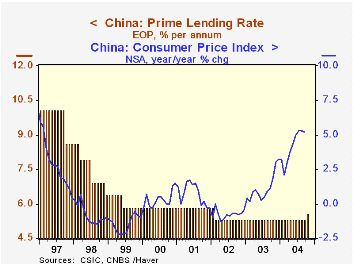 Global| Oct 29 2004
Global| Oct 29 2004People's Bank of China Raises Lending Rate; Removes Cap on Bank Rates in Major Monetary Policy Shift
Summary
The People's Bank of China surprised world markets yesterday with a hike in its prime lending rate to 5.58% from 5.31%. The former level had been in place since February 2002. The move concludes an 8-1/2 year span of rate cuts. While [...]

The People's Bank of China surprised world markets yesterday with a hike in its prime lending rate to 5.58% from 5.31%. The former level had been in place since February 2002. The move concludes an 8-1/2 year span of rate cuts. While a surprise in terms of exact timing, the Bank's action was not totally unexpected. In the spring it had used moral suasion to talk commercial banks into restraining their own loan growth; several Asian economists were forecasting a rate hike to make the attitude of restraint more concrete. (The Bank also raised its companion "deposit rate" to 2.25% from 1.98%.)
Further, in an additional step, the central bank removed a cap on rates commercial banks may charge their own customers. Previously, they were limited to rates no higher than 1.7 times the central bank lending rate. For the last couple of years this was equivalent to 9.03%. But in the face of the recent policy of qualitative restraint on lending, companies are said to have been resorting to "underground" channels for financing, and according to press sources, have been paying 15% to 20% for loans. Now, a more active and open bank credit market should develop.
Undesirably high inflation is prompting these actions, as well as a desire, bank officials indicated, to encourage behavior in the Chinese banking system that more closely resembles practices in international banking markets. Perhaps this evolutionary and philosophical move toward freer markets is the real surprise in this monetary policy action.
Meantime, inflation has indeed risen. The 12-month change in the consumer price index has been above 5% since June and was 5.2% in September. These last four months have seen the strongest pace since early 1997. Producer prices and corporate goods prices suggest continuing cost pressures, with the PPI up 7.9% for the 12 months ending September, the highest rate in the nearly eight-year history of the data. Corporate goods prices, another wholesale price measure, show strong gains in most types of products, with the total up 9.6%.
| 12-Month % Changes, NSA | Sept 2004 | Aug 2004 | Jul 2004 | December/December|||
|---|---|---|---|---|---|---|
| 2003 | 2002 | 2001 | ||||
| Consumer Price Index | 5.2 | 5.3 | 5.3 | 3.2 | -0.4 | -0.3 |
| Producer Price Index | 7.9 | 6.8 | 6.4 | 3.0 | 0.4 | -4.0 |
| Corporate Goods Price Index | 9.6 | 9.5 | 9.4 | 6.3 | -0.5 | -2.5 |
Carol Stone, CBE
AuthorMore in Author Profile »Carol Stone, CBE came to Haver Analytics in 2003 following more than 35 years as a financial market economist at major Wall Street financial institutions, most especially Merrill Lynch and Nomura Securities. She had broad experience in analysis and forecasting of flow-of-funds accounts, the federal budget and Federal Reserve operations. At Nomura Securities, among other duties, she developed various indicator forecasting tools and edited a daily global publication produced in London and New York for readers in Tokyo. At Haver Analytics, Carol was a member of the Research Department, aiding database managers with research and documentation efforts, as well as posting commentary on select economic reports. In addition, she conducted Ways-of-the-World, a blog on economic issues for an Episcopal-Church-affiliated website, The Geranium Farm. During her career, Carol served as an officer of the Money Marketeers and the Downtown Economists Club. She had a PhD from NYU's Stern School of Business. She lived in Brooklyn, New York, and had a weekend home on Long Island.





